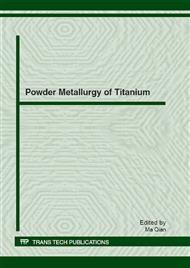[1]
Z. Fan, The β→ω transformation during room temperature aging in rapidly solidified Ti-6Al-4V alloy, Scripta Metallurgica et Materialia, Vol. 31 (1994), 1519-1524.
DOI: 10.1016/0956-716x(94)90067-1
Google Scholar
[2]
G. Welsch, Gerd Lütjering, Kanay Gazioglu, Wolfgang Bunk, Deformation characteristics of age hardened Ti-6Al-4V, Metallurgical and Materials Transactions A, Vol. 8 (1977), 169-177.
DOI: 10.1007/bf02677278
Google Scholar
[3]
T. Ahmed, H. J. Rack, Phase transformations during cooling in α+β titanium alloys, Materials Science and Engineering: A, Vol. 243 (1998), 206-211.
DOI: 10.1016/s0921-5093(97)00802-2
Google Scholar
[4]
S. Malinov, W. Sha, Z. Guo, C. C. Tang, A. E. Long, Synchrotron X-ray diffraction study of the phase transformations in titanium alloys, Materials Characterization, Vol. 48 (2002), 279-295.
DOI: 10.1016/s1044-5803(02)00286-3
Google Scholar
[5]
L. M. Wang, H. C. Lin, The characterization of corrosion resistance in the Ti-6Al-4V alloy fusion zone following a gas tungsten arc welding process, Journal of materials research, Vol. 24 (2009), 3680-3788.
DOI: 10.1557/jmr.2009.0444
Google Scholar
[6]
K. Borggreen, I. Wilson, Use of postweld heat treatments to improve ductility in thin sheets of Ti-6Al-4V, Welding Journal, Research Supplement, Vol. 59 (1980), 1s-9s.
Google Scholar
[7]
K. K. Murthy, S. Sundaresan, Fracture toughness of Ti-6Al-4V after welding and postweld heat treatment, Welding Journal, Research Supplement, Vol. 76 (1997), 81s-91s.
Google Scholar
[8]
S. H. Wang, M. D. Wei, L. W. Tsay, Tensile properties of LBW welds in Ti–6Al–4V alloy at evaluated temperatures below 450 °C, Materials Letters, Vol. 57 (2003), 1815-1823.
DOI: 10.1016/s0167-577x(02)01074-1
Google Scholar
[9]
D. A. Porter, K. E. Easterling, Phase transformations in metals and alloys, second, Chapman & Hall, London, (1995).
Google Scholar
[10]
R. Roger, E.W. Collings, G. Welsch, Materials Properties Handbook: Titanium Alloys, ASM International, (1994).
Google Scholar
[11]
B. D. Cullity, Elements of X-ray Diffraction, Addison. Wiesley publishing company, Inc., (1978).
Google Scholar
[12]
K. Y. Wang, C. M. Ger, Y. B. Jeo, Titanium for aerospace, Shanghai science technology, Shanghai, (1985).
Google Scholar
[13]
J. W. Elmer, T. A. Palme, Joe Wong, In situ observations of phase transitions in Ti-6Al-4V alloy welds using spatially resolved x-ray diffraction, journal of applied physics, Vol. 93 (2003), 1041-1047.
DOI: 10.1063/1.1537464
Google Scholar
[14]
O. Hunziker, D. Dye, R. C. Reed, On the formation of a centreline grain boundary during fusion welding, Acta Materialia, Vol. 48 (2000), 4191-4201.
DOI: 10.1016/s1359-6454(00)00273-1
Google Scholar
[15]
S. Djanarthany, J. C. Viala, J. Bouix, An overview of monolithic titanium aluminides based on Ti3Al and TiAl, Materials Chemistry and Physics, Vol. 72 (2001), 301-319.
DOI: 10.1016/s0254-0584(01)00328-5
Google Scholar
[16]
S. Sastry, H. Lipsitt, Ordering transformations and mechanical properties of Ti3Ai and Ti3Al-Nb alloys, Metallurgical and Materials Transactions A, Vol. 8 (1977), 1543-1552.
DOI: 10.1007/bf02644857
Google Scholar
[17]
N. F. Lashko, L. V. Zaslavskaya, M. N. Kozlova, Physico-Chemical Phase Analysis of Steels and Alloys, Metallurgia, Moskva, (1978), 336.
Google Scholar
[18]
Y. Mishin, Chr Herzig, Diffusion in the Ti–Al system, Acta Materialia, Vol. 48 (2000), 589-623.
DOI: 10.1016/s1359-6454(99)00400-0
Google Scholar
[19]
T. Namboodhiri, C. McMahon, H. Herman, Decomposition of the α-phase in titanium-rich Ti-Al alloys, Metallurgical and Materials Transactions B, Vol. 4 (1973), 1323-1331.
DOI: 10.1007/bf02644528
Google Scholar
[20]
Y. Q. Xie, K. Peng, X. B. Liu, Influences of xTi/xAl on atomic states, lattice constants and potential-energy planes of ordered FCC TiAl-type alloys, Physica B: Condensed Matter, Vol. 344 (2004), 5-20.
DOI: 10.1016/j.physb.2003.06.002
Google Scholar
[21]
J. W. Elmer, T. A. Palmer, S. S. Babu, W. Zhang, T. DebRoy, Phase transformation dynamics during welding of Ti–6Al–4V, Journal of Applied Physics Vol. 95 (2004), 8327-8340.
DOI: 10.1063/1.1737476
Google Scholar
[22]
R. O. Yoshikazu, H. Onodera, K. Ohno, T. Yamagata, I. Tomizuka, M. Yamazaki, Effects of volume fraction and grain size on creep characteristics of α/β titanium alloys, Transactions ISIJ, Vol. 26 (1986), 322-327.
DOI: 10.2355/isijinternational.29.165
Google Scholar
[23]
C. Y. Yu, C. C. Shen, T. P. Perng, Microstructure of Ti–6Al–4V processed by hydrogenation, Scripta Materialia, Vol. 55 (2006), 1023-1026.
DOI: 10.1016/j.scriptamat.2006.08.010
Google Scholar
[24]
F. H. Froes, O. N. Senkov, J. I. Qazi, Hydrogen as a temporary alloying element in titanium alloys: thermohydrogen processing, International Materials Reviews, Vol. 49 (2004), 227-245.
DOI: 10.1179/095066004225010550
Google Scholar
[25]
A. A. Ilyn, B. A. Kolachev, A. M. Mamonov. Titanium '92: Science and Technology. Warrendale, PA,: The Minerals, Metals and Materials Society. (1992).
Google Scholar
[26]
A. A. Ilyn, A. M. Mamonov, Russ. Metall., Vol. 5 (1994), 52.
Google Scholar
[27]
G. Welsch, W. Bunk, Deformation modes of the α-phase of Ti-6Al-4V as a function of oxygen concentration and aging temperature, Metallurgical and Materials Transactions A, Vol. 13 (1982), 889-899.
DOI: 10.1007/bf02642403
Google Scholar


